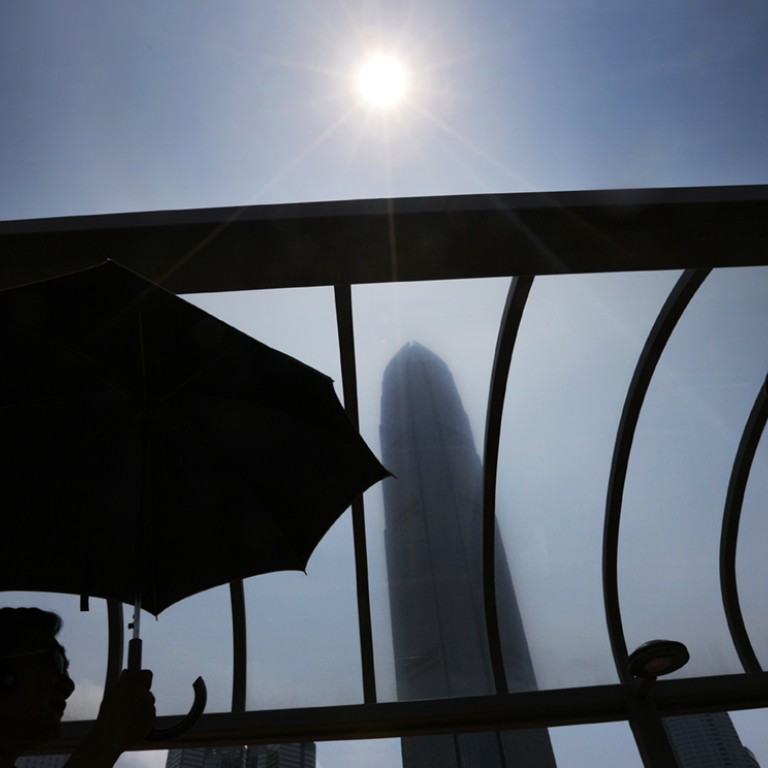
Urban heat island effect big factor in climate change, Hong Kong records show
Heat from human activity a big factor in climate change, HK records show
Temperature and rainfall are the two most basic elements in climate change. So what can we learn from a study of local temperature records and why might it be that local factors other than carbon dioxide output are the main cause of rising temperatures in our city?
Climate change is defined by the United Nations Framework Convention on Climate Change as that attributable directly or indirectly to human activity that alters the composition of the global atmosphere and is in addition to natural climate variability. This definition challenges scientists to distinguish clearly between natural and human-induced causes.
However, the Intergovernmental Panel on Climate Change (IPCC) defines climate change as changes in the state of the climate that can be identified - for example, by using statistical tests - in such features as temperature and sea levels and that persist for an extended period, typically decades or longer. Short time periods of less than 10 years have been excluded. The changes may be due to natural variability or as a result of human activity.
The Hong Kong Observatory was established in 1883. Continuous temperature records have been kept since 1884 except during the seven years 1940-1946 encompassing the second world war.
Temperature measurements at the observatory are known historically to be influenced significantly by the urban heat island effect, defined as urban pockets that are significantly warmer than their surroundings due to human activities.
A comparative study in 1988 of temperature records from the observatory in Tsim Sha Tsui and Macau monitoring stations attributed the warmest temperatures, and a temperature increase of about 0.9 degrees Celsius at the observatory between 1884 and 1986, to heat trapping in the Victoria Harbour basin. This is best explained by the urban heat island effect resulting from rapid population growth and lifestyle changes within the basin.
A comparative study of temperature records for the period from 1968 to 2013 obtained from the observatory and the monitoring station on Waglan Island, off the southeast coast of Hong Kong Island, shows the annual temperature differences ranging from 1.3 to 1.5 degrees Celsius in the years from 1994 to 1998 can be satisfactorily accounted for by heat generation through infrastructural development. Heat was contributed by engineering projects include the West Kowloon Reclamation and the construction of the Tsing Ma Bridge.
A detailed study of Hong Kong's urban heat island intensity was made last year. It compared temperatures at the observatory and the monitoring station at Pak Tam Chung in Sai Kung. The difference in annual mean temperatures between them was found to fall within a range of 1.9 to 3.8 Celsius.
Hong Kong temperature records also show that:
- The mean annual temperature at the observatory up to 2013 was 22.6 Celsius, with a low of 21.3 Celsius (in 1884, the year after the Krakatoa volcano erupted in Indonesia) and a high of 24 Celsius (in 1998);
- Since 1998 there has been a pause in temperature rise at the observatory in spite of the growing influence of the urban heat island effect;
- A longer pause in temperature rise at the observatory occurred between 1966 and 1998;
- The record year for very hot days - those with daily maximum temperatures of 33 Celsius or more - was 1963 (37 days), and the record year for very hot nights - those with nightly maximum temperatures of 28 Celsius or more - was 1998. While 1963 may be explained by the weather conditions during the driest year on record, the hottest year on record, 1998, also produced the record for very hot nights;
- Between 2004 and 2013 the number of cold days - when the daily minimum temperature is 12 Celsius or less - ranged between 45 and 75 a year at the Pak Tam Chung station but only between eight and 32 a year at the observatory in Tsim Sha Tsui; and
- Temperature measurements from the observatory require correction for the urban heat island effect.
Heat generated by human activities within the urban areas and Victoria Harbour is the most obvious cause of the temperature changes observed at the observatory. However, natural changes as a result of major volcanic eruptions that cause temperatures to fall can also be identified. Examples include the eruption of El Chichon in Mexico in 1982 and of Mount Pinatubo in the Philippines in 1991.
The pattern of temperature variation observed in Hong Kong supports the contention that carbon dioxide - despite its concentration rising steadily at a rate of about two parts per million per year - is not responsible for driving temperature increases. The real culprit is heat generated by human activities which causes pollution and evaporation, enabling more water vapour to enter the atmosphere.
The Hong Kong temperature records reaffirm that clouds formed by water droplets and/or ice crystals and water vapour are mainly responsible for the greenhouse effect, followed by carbon dioxide. This was pointed out in the authoritative climate change statement of the Royal Society in 2010.
If we are serious about "human-induced" climate change, reducing carbon dioxide levels alone cannot be an effective solution.
Want more articles like this? Follow SCMP Lifestyle on Facebook!
